The Carden-Loyd based CV 29 tankette.
In june 1940, when italy declared war to France, the CV 33 and 35 were, by far, the most numerous tank model in service in the whole Regio Esercito (Royal Italian Army). This was a combination of three factors : The international export success of the British Carden-Loyd concept of mini-tank or "tankette", the need in 1933 of a fast infantry tank for colonial conquest (the CV33 will indeed form the bulwark of the Italian armoured forces during the Ethiopian campaign), and a lack of industrial resources and capacity which prevented to built bigger tanks during these years... Eventually, no less than 2700 were delivered, from which 1216 exported and 1506 took service with the Regia Esercito.The Carden-Loyd licence was acquired by Fiat in 1929, and a first protype was ready in the same year, called CV 29 for "Carro Veloce modello 1929". Carro Veloce for "fast tank", its main caracteristic, which suited well the Italian head of staff tactical theories. The aim of this was to create an effective mechanized division combining fast tanks and trucks carrying infantry. As such, the CV 29 was lightweight, small and cramped machine, using just one machine-gun at the start. The CV 29 was protected at minimal requirements, sustaining only rifle bullets. Untimately, twenty one of these "pre-production" models were built, used in exercises and serving as testbeds for improvements which led to the large production model CV 33.
First production CV 33.
The CV 33 was the first mass-produced tank in service in the Royal Italian army. 300 were ultimately built by Fiat Company of Turin and the Ansaldo Company of Genoa until 1935. The Carro Veloce Modello 33 was slightly lenghtened, widened and has a better engine, the petrol six-cylinder watercooled FIAT-SPA CV3 capable of delivering 43 horsepower (32 kw). The suspension and tracks were almost untouched, but the armour was slighlty increased to 14 mm for the frontal part and sides, and the overall weight jumped to 3,2 tons, with speed slightly decreased. In theory, this gave these tanks the ability to sustain most rifle antitank bullets and heavy machine gun fire (then 12,7 or 13 mm). But the rear, roof and lower hull were still too tiny for this. Plus, modern AT rifles in 1940 were capable of piercing these frontal armor with ease. As a consequence, in 1938, all CV 33 (then called L33/3) were retrofitted alongside the CV35 upgrade. The serie I was superseded by the Serie II in 1936, with a twin 8 mm mount. This proved more effective and all but a few other Serie I conversions were retrofited.Evolution : The CV 35.
There were two main differences between the two models. The CV35 armour was bolted rather than beeing riveted, and the FIAT mod.14, 8 mm twin mount was a standard. These were replaced later by FIAT mod.34 or Breda mod.38. There were also minor modifications between models depending of the parts used and the manufacturer. This new model was mass-produced, and consequentely many CV 33 (then L3/33 in 1938) were retrofitted alongide L3/35 model. The L3/35 armour war also slightly heavier but with a more powerful FIAT SVA petrol engine, the speed was almost unchanged. The twin mount was an ingeneous system which allow lateral and vertical aiming easily, but in the desert, sand dust proved to jam this mount. The upper part of the tracks was supported by Acacia wooden trails. A large encasing was placed just after the forward wheel to accomodate spare parts. The serie II was different only on minor details.Last model : The CV 38.
Called L3/38 in 1840, this was the last evolution of this tankette, largely based on the Brasilian export version. This last one had a single Breda mod.31 Tipo Marina (navy model) of 13.2 mm which hold more firepower, and a Breda 20 mm antitank rifle could have been mounted instead. The wheel, suspension and bogie system was entirely new : The former system was replaced by four wheels on two bogies, which allowed a smoother ride. After the Brasilian production, other were produced from 1942 to the Italian Armistice. A few were used in the Sicilian campaign by Italian forces, most were captured and used by the Wehrmacht afterwards.Main variants.
The overall limited size and power-to-weight ratio of this vehicle prevented extensive modifications, but several armaments were tested. First, a single Breda 13,2 mm machine guns proved far more effective than the usual 7,9 mm pair, or a twin mount with Cal.7 Madsen 13 mm. The last one was designed for export and most sold to Brasil (23 units in total). A few Breda models (on serie L3/35 II) were seen in action, mostly in Sicilia and Tunisia. Another variant was L3 Zapattori, a bridge carrier used by the royal corp of engineers based on the L33/3 (seen the video after). The L33 LF (for "Lanciaflamme") was a flamethrower version, adapted on L33/3 serie II and L33/5 serie I-II versions. There was also an aircraft carried version, the Aviotrasportabile. It was widely used in the African campaign and proved valuable against British fortifications, but seen service from the Abyssinian campaign to the Armistice. The L3/R was a radio version, largely used as command tanks during the African campaign. The L3 cc (Controcarro) was the only adapted antitank version, using the 20 mm Solothurn AT rifle. A few were built and used in Africa. There were also several prototypes of conversions, including the Semovente L3 da 47/32, a 47 mm gun carrier. The production was never launched.Exports.
Due to its low cost (86 800 lires in 1935), the Ansaldo-FIAT CV33 and CV35 were successfully exported, some in south america : Brasil, Bolovia and Paraguay received around forty units in all. Some were used during the Chaco war. Other were sold to Albania (6), 72 to Austria and 10 to Bulgaria (both with German Schwartzlose Mgs), and Hungary, which ultimately built a custom version with a Brno 26 Mg and a new turret hatch. All were used with axis forces. A few were sold to Greeks, used against the Italians in 1940, and captured in 1941 by the Germans, which retroceded them to the Italians. More than a hundred were sold to China, which fought the Japanese, and were heavily modified. Also a handful were sold to Irak and Afghanistan. Spanish Nationalist forces received also a dozen or more CV33 which were used in 1939, at the very end of the war, and a special-purpose model was to be produced with a Mod. 35 Breda 20 mm gun, called the Trubia. A single prototype was ultimately built, but several Spanish Panzer I were rearmed with this gun.Wartime career of the Carro Veloce.
The L3 career is quite impressive, spanning from the Abyssinian (Ethiopian) campaign to the reddition of Kesselring german troops in Italy, in may 1945... Despite its light armor, the CV 33 and 35 were reliable, fast with a low profile, which made them difficult to hit, and had a low petrol consumption. They were a cost-effective solution, still valuable against infantry alone. Just as the British Unversal Carriers, they were available in large numbers, used in many ways, as scouts, equipped with powerful radios, as advanced screening and flanking forces, for colonial and police duties, for assaults in flame-thrower versions, or even as anti-tank vehicles, armed with a highly effective Breda 20 mm gun. Most of the export version seen combat as well. But the CV 33 had several nicknames which reflected its lack of armor in Italian service : "scatola di sardine" or "cassa de morto" (beer or sardine boxes), or even "bara d'acciaio" (iron coffins)...Links about the CV33-35-38
About the L3/33 on Wikipedia
About the L3/35 on Wikipedia
More characteristics
A video closup of an Ariete CV33 at museum
A well documented page about the L3 family (in french)
A video about CV 33 Tankette in exercises (British Path� archives).
Another video showing the CV35 Carro Getaponte of the royal corps of engineers operating in exercises, 1940 (Luce archives).
| Specs. | CV 33 | CV 35 | CV 38 |
| Dimensions (L-W-H): | 3,03x1,4x1,2 m | 3,17x1,4x1,3 m | 3,17x1,5x1,3 m |
| Total weight, battle ready : | 2,9 Tons | 3,2 Tons | 3,5 Tons |
| Crew : | 2 | 2 | 2 |
| Propulsion : | Fiat SPA CV1 6 cyl 38hp | Fiat SPA CV3 6 cyl 43hp | Fiat 122AC/B 6 cyl 42/46hp |
| Speed : | 40 km/h | 42 km/h | 45 km/h |
| Range (road) | 125 km | 125 km | 110 km |
| Armament (see notes): | Breda 7,92 mm Mg | Breda 7,92 mm Mg | Breda 7,92 mm Mg |
| Armour : | From 5 to 10 mm | From 6 to 12 mm | From 8 to 14 mm |
| Total production | around 1200 | around 1300 | around 200 |
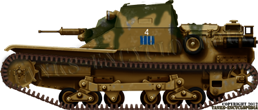
Carro Veloce CV33, early production (Serie I), Ariete division, Libya, january 1940.
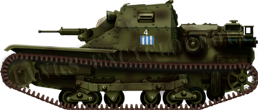
Carro Veloce CV 35 serie II, Ariete division, Libya, may 1941.
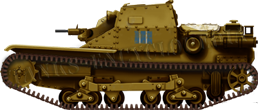
Carro Veloce CV35 (L33/5) with the special twin Breda 13 mm heavy machine-gun mount, Ariete division, Libya, march 1942.
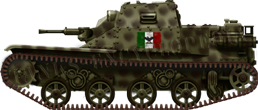
L3/38 of the so-called "Repubblica Soziale Italiana" (Fascist "Republic of Salo"), LXXXXVII "Liguria" Army (Graziani) september 1944, in the Gothic line tactical reserve, facing France. This model was used also mostly by the Wehrmacht.
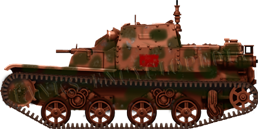
L3/38R (Radio version) used as a command tank, "Friuli" division based in Corsica, november 1942 (General Umberto Mondino). Four Italian divisions were commited to the occupation of Corsica after the German invasion of the French Vichy so-called "free zone". This was a strategical response to the allied landings in North Africa (operation Torch).
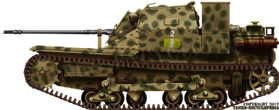
L3/35 cc ( "cc" stood for "contro carro" Antitank version) an adaptation of the elderly CV 35, "Centauro" division which arrived to late in Lybia, missing El Alamein. However under Kesselring and Rommel they performed a good fightning retreat into Tunisia. Some CV 33 were thrown at Kasserine pass against freshly landed GIs. The 20 mm Solothurn rifle was produced initially by a firm controlled by Rheinmetall, in Switzerland. It was heavy, cumbersome and had a huge recoil, but a far better muzzle velocity than the British Boys, and were able to pierce any armour up to 35 mm. As a result, many L3 were successfully converted as antitank platforms.
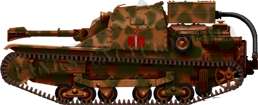
The LF version was the most produced of all L3/35 conversions. They were equipped with a towed tank or carrying their own (illustration), of Napalm or alcool mixed gasoline. They were used against fixed position in Africa, fighting at Tobruk, Gazala, El Alamein.
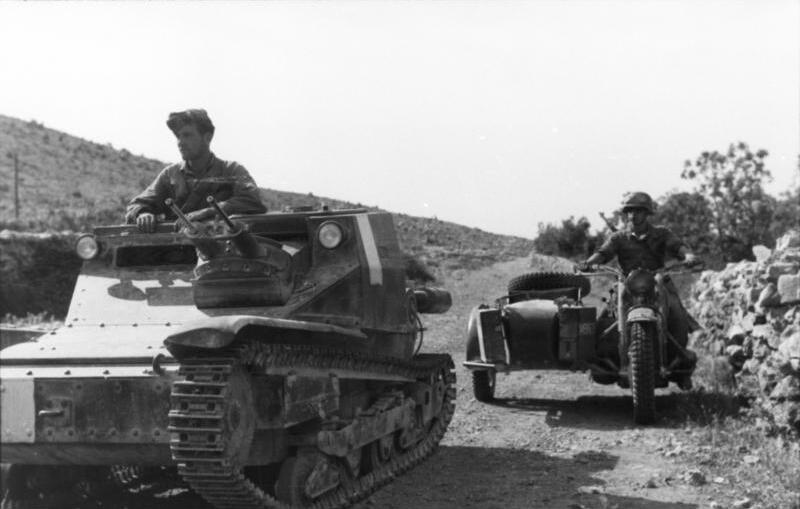
A L3/35 in a Balkanic Italo-German anti-partisan operation, september 1943 (Bundesarchiv).

WW2 Tanks




























WW2 tanks posters

All Tiger tanks liveries.

Panther liveries and variants

WW2 Armour - All tanks











Tanks aces and single tanks series

Find more there

Museums, Movies, Books & Games
The Tanks and Armor in pop culture
Tanks and armored vehicles in general are only really grasped when seen first person: The mass, the scale, it's all there. Explore also the way tanks were covered in the movie industry, in books and in video games.Movies:
Best tanks movie on warhistoryonline.com
On imdb.com
On bestsimilar.com/
miltours.com
liveabout.com/
watchmojo.com
Video Games:
pcgamesn.com
historyhit.com
levvvel.com
vg247.com/best-tank-games
mmobomb.com/
alienwarearena.com

